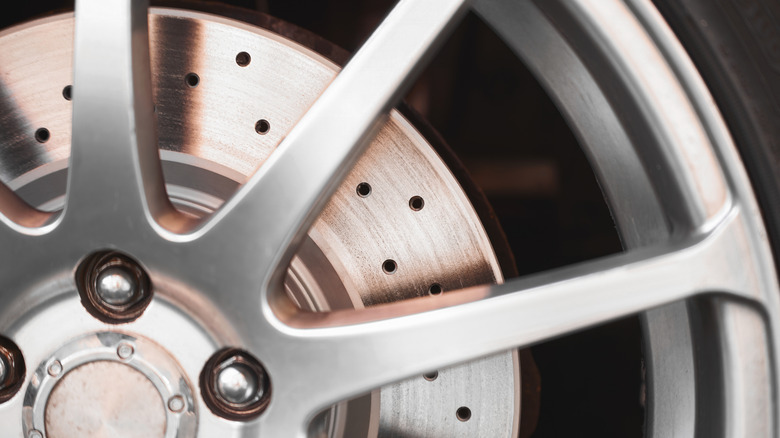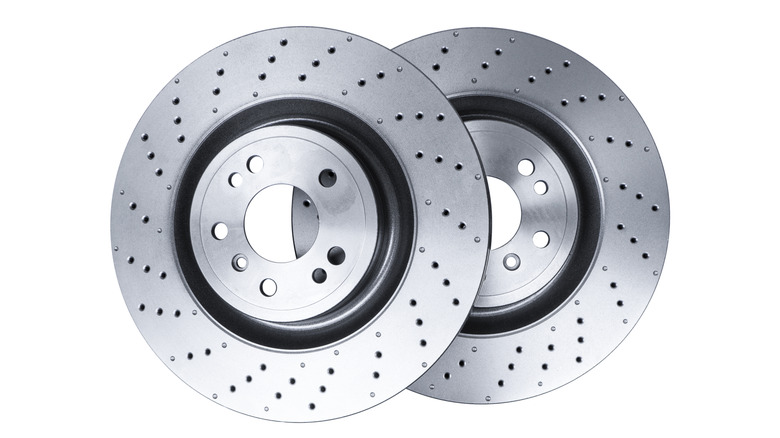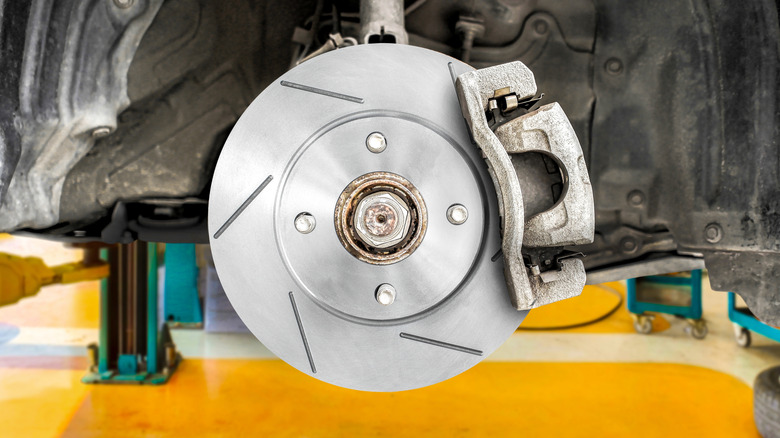Drilled Vs. Slotted Rotors: What's The Difference?
Automotive brakes have advanced leaps and bounds over the past century, but the physics behind how they work remains the same: brakes slow a car down by converting a tire's rotational energy into thermal energy. A typical disc brake assembly comprises several elements, namely the brake rotor itself, the caliper, and the pads. The caliper is basically a hydraulically-operated clamp, squeezing the friction material of the pads against the rotor like a person's hand, stopping the car. This process naturally generates heat, and that heat will subsequently need to be dissipated to maintain adequate braking force. Two innovations have since arisen which (slightly) address this need: drilled and slotted rotors.
Drilled rotors, also called cross-drilled rotors, feature holes drilled clean through the brake rotor. Slotted rotors, meanwhile, utilize long grooves cut in the rotor face. In both cases, the concept remains the same of improving brake performance under specific conditions, including extreme temperatures and rainfall, in addition to adding a bit of "sportiness" to your ride. They each perform these tasks by utilizing the empty space underneath the pad as it passes while under braking. While each type of rotor functions the same, however, each is better-suited to its own performance driving style, though daily driving with them won't yield any noticeable changes between the two. But for more serious, aggressive applications, a quality drilled or slotted rotor improves braking performance in several facets.
Drilled/cross-drilled rotors are designed for long-distance braking
There's no specific date on when cross-drilled rotors first found use, since they're fairly remedial and intuitive to create, but sources agree that it was in the 1960s during the heyday of the Muscle Era. Classic cars like these were large, heavy, and featured 1960s brake technology, so it was likely an innovation performed by teams looking to extract long-distance braking performance over a race. However, drilled rotors today feature the holes cast into the surface, rather than being drilled after the brake rotor is finished.
The key to how these brakes function lies in what happens when the brakes overheat, causing brake fade. As brakes accrue more heat during hard driving, they develop pockets of gas between the rotor and the pad, which act as a cushion. Like what happens when a car hydroplanes, this effectively creates a frictionless barrier between the two surfaces, causing the pad to "skip" and momentarily lose grip. The drilled holes provide an escape route for the gas, meaning it significantly improves long-term brake fade when racing. This general rule also applies to water getting trapped between the two surfaces, making drilled rotors useful in wet-weather racing as well.
The main downside of drilled rotors is that, over time and exposure to these extreme conditions, the brakes will gradually lose structural integrity and crack. This problem is especially prevalent in rotors with holes drilled after manufacturing, compromising their structural integrity. However, it also applies to rotors with cast holes, though to a lesser extent. Dimpling, or drilling only partway through the rotor, also helps to mitigate stress fracturing.
Slotted rotors
Unlike drilled rotors, slotted rotors feature no such holes running through the brake rotor, meaning there's no danger of stress cracks developing. This means that, whereas drilled rotors are better suited to shorter-distance extreme braking, slotted rotors work well with endurance applications. Drivers should only use slotted rotors when racing on track because they offer many of the same benefits without the holes creating focal points for stress fractures.
The slots function in generally the same way as the holes in drilled rotors, serving as a means to evacuate gas and dust buildup between the pad and rotor. Additionally, they provide the perk of an additional biting surface for the pad to contact, though this also results in the downside of increased pad wear (along with the telltale signs of worn pads). However, if you look at many top-end race cars like Formula One, Le Mans prototypes, and Indycar, you'll notice that almost no series feature slotted or drilled rotors. Instead, they feature full-face brakes with holes in the sides of the rotors, known as vented rotors. The vents in these rotors act like heat radiators, increasing the surface area to keep the temperatures consistent.
Lastly, brake rotors may feature all three elements in one rotor. However, these also combine all the inherent drawbacks of each rotor as well. As such, they are particularly well-suited to towing and other extreme applications involving sudden heavy braking. They also look cool, which is another valid option for many daily drivers looking for a sportier image.


